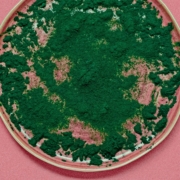Spirulina
Spirulina (Arthrospira platensis & A. maxima) is a blue-green algae with enormous nutritional value. It is consumed as a dried powder with a dark green color. Chlorella (Chlorella vulgaris), a green algae is just as nutritious to its blue-green cousin, with a few differences in specific nutrients. For the sake of simplcity I will focus on spirulina in this monograph.
Spirulina’s nutritional profile is impressive. It is the most nutrient-dense plant in the world (Nettles is a close second, being the most nutrient-dense land-plant in the world). The blue-green algae is made up of 50-65% amino acids, including the essential fatty acid gamma linolenic acid (GLA). It is also chalk full of vitamins and minerals including B vitamins, carotenes, iron, calcium and chlorophyll.
Chlorophyll, which gives this algae its deep green color, is a key component in the process of photosynthesis. It helps plants to absorb the sun’s light energy and convert it into glucose. We have thought that the ability to utlilize the sun’s energy was limited to the plant kingdom, but recent studies suggest that humans can also utilize the sun’s energy in the presence of chlorophyll.
“Here we show that mammalian mitochondria can also capture light and synthesize ATP when mixed with a light-capturing metabolite of chlorophyll.” (1)

- tonic for the blood & spleen
- anti-oxidant
- anti-inflammatory
- hypoglycemic (lowers blood sugar) (3)
- hypolipidemic (lowers blood lipids) (3)
These properties suggest that spirulina could be beneficial for the following:
- reducing the severity of allergies and other inflammatory conditions by helping to detoxify, nourish and invigorate the blood.
- improving overall metabolism
- regulating blood sugar & triglycride levels
- supporting weight loss & impoving energy levels
Consider adding spirulina into your daily life if you are are feeling depleted, sluggish or overweight, or if you are wondering if you are getting enough essential nutrients in your daily diet.
I recently began to add spirulina into my daily protocol (click here to see my protocol & recipes) and can attest to the significant improvement in energy that I feel. I use it as an after-lunch pick me up and it helps me maintain mental clarity through the afternoon. I am excited to see how this changes with throughout the year with increasing my time spent outdoors in the warmer months.
This information is for educational purposes only and is not intended to prevent, treat or diagnose any disease.
Works Cited
- https://jcs.biologists.org/content/joces/127/2/388.full.pdf
- https://pubmed.ncbi.nlm.nih.gov/19299804/
- https://pubmed.ncbi.nlm.nih.gov/22561632/
